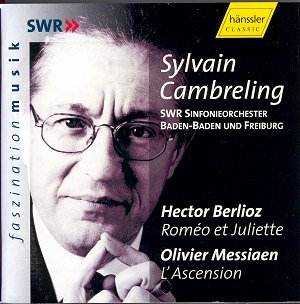 |
Hector BERLIOZ
(1803-69) Roméo et Juliettea. Olivier MESSIAEN (1908-92) L'Ascensionb. Recorded in the Konzerrthaus, Freiburg on aMay 28th-30th, 1998, bSeptember 13th-15th, 1999. [DDD] Crotchet AmazonUK AmazonUS Amazon recommendations |
Berlioz referred to his Roméo et Juliette as a ‘symphonie dramatique’, and Sylvain Cambreling certainly takes note of the drama of this fascinating score. It seems that Cambreling’s gifts have yet to achieve full recognition in the UK, but a glance at his biography reveals extensive operatic background, including Messiaen’s St François d'Assise in 1992 at the Opéra Bastille in Paris and a Pelléas et Mélisande with the LPO at Salzburg.
Certainly the South West German Radio Symphony Orchestra, Baden-Baden und Freiburg (of whom Cambreling is chief conductor) seem to respond keenly to his ear for detail and clarity, both in Berlioz and in Messiaen. They are quite simply superb throughout: listen, for example, to the extended opening of the Second Part of Roméo. The lightness of delivery of the famous ‘Queen Mab’ Scherzo which concludes this part is a thing of wonder, and throughout powerful passages are balanced as carefully as pianissimo ones. Enhancing the experience is the EuropaChorakademie, whose choral contribution positively makes the performance. Their ghostly, emaciated, hushed singing in the Third Part is particularly impressive (only the high sopranos yield to the London Symphony Chorus on Colin Davis’ most recent version, LSO Live LSO0003).
The idea of coupling Berlioz with Messiaen works beautifully: both reveal almost superhuman sensitivity to instrumental colour, each in his own individually Gallic way. Cambreling and his forces are every bit the equal of their major rivals, the Paris-Bastille Orchestra under Chung (DG 435 854-2). There is a contained power to Cambreling’s brass in the first movement, and the third is full of life. The final movement, however, is the crown of this set: the luminous, slow moving textures emerge hypnotically as Cambreling bathes the listener in a aural pool of light.
A truly impressive release that I urge all to hear.
Colin Clarke